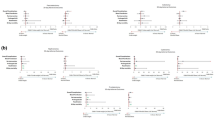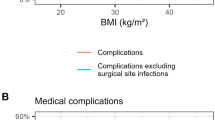Abstract
Background
Although surgical studies have reported inconsistent associations between increased body mass index (BMI) and operative outcomes, the accuracy of BMI for measuring obesity has been questioned in previous epidemiologic studies. Simultaneously, BMI has known comorbidities, which may mediate the effect of BMI if included in multivariable models. We sought to examine the effect of BMI on operative outcomes after adjusting for preoperative factors.
Methods
We identified 8858 patients who underwent major thoracic, abdominal, and pelvic surgery for solid organ tumors in American College of Surgeons National Surgical Quality Improvement Program (ACS NSQIP) centers from 2005 to 2007. We used multivariable analyses to assess the effect of BMI on short-term operative outcomes after controlling for covariates.
Results
Increased BMI was not associated with worse short-term operative outcomes in our bivariable analyses. However, patients with BMI ≥35 had higher American Society of Anesthesiologists scores, longer operative times, and an increased number of postoperative complications (P < 0.0001). After adjusting for pre- and intraoperative factors, BMI did not predict any short-term operative outcome except for an increased total number of complications in BMI ≥35. These results persisted after removing potential mediators from the multivariable analysis.
Conclusions
In ACS NSQIP, BMI has minimal association with short-term operative outcomes after major cancer surgery. Although these findings may suggest a lack of association between obesity and cancer surgery outcomes, it confirms the previously examined limitations of BMI. Because of the rising incidence of obesity in the United States and its challenging effect on surgeon’s practice, ACS NSQIP should consider exploring alternative measures of general and abdominal obesity.



Similar content being viewed by others
References
Mokdad AH, Serdula MK, Dietz WH, et al. The spread of the obesity epidemic in the United States, 1991–1998. JAMA. 1999;282:1519–22.
Mokdad AH, Serdula MK, Dietz WH, et al. The continuing epidemic of obesity in the United States. JAMA. 2000;284:1650–1.
Mokdad AH, Bowman BA, Ford ES, et al. The continuing epidemics of obesity and diabetes in the United States. JAMA. 2001;286:1195–200.
Mokdad AH, Ford ES, Bowman BA, et al. Prevalence of obesity, diabetes, and obesity-related health risk factors, 2001. JAMA. 2003;289:76–9.
Birkmeyer NJ, Charlesworth DC, Hernandez F, et al. Obesity and risk of adverse outcomes associated with coronary artery bypass surgery. Northern New England Cardiovascular Disease Study Group. Circulation. 1998;97:1689–94.
Gedaly R, McHugh PP, Johnston TD, et al. Obesity, diabetes, and smoking are important determinants of resource utilization in liver resection: a multicenter analysis of 1029 patients. Ann Surg. 2009;249:414–9.
Hawn MT, Bian J, Leeth RR, et al. Impact of obesity on resource utilization for general surgical procedures. Ann Surg. 2005;241:821–6.
Kodera Y, Ito S, Yamamura Y, et al. Obesity and outcome of distal gastrectomy with D2 lymphadenectomy for carcinoma. Hepatogastroenterology. 2004;51:1225–8.
Merkow RP, Bilimoria KY, McCarter MD, et al. Effect of body mass index on short-term outcomes after colectomy for cancer. J Am Coll Surg. 2009;208:53–61.
Mullen JT, Davenport DL, Hutter MM, et al. Impact of body mass index on perioperative outcomes in patients undergoing major intra-abdominal cancer surgery. Ann Surg Oncol. 2008;15:2164–72.
Nair S, Verma S, Thuluvath PJ. Obesity and its effect on survival in patients undergoing orthotopic liver transplantation in the United States. Hepatology. 2002;35:105–9.
Tsujinaka T, Sasako M, Yamamoto S, et al. Influence of overweight on surgical complications for gastric cancer: results from a randomized control trial comparing D2 and extended para-aortic D3 lymphadenectomy (JCOG9501). Ann Surg Oncol. 2007;14:355–61.
National Institutes of Health. National Heart, Lung, and Blood Institute. Clinical guidelines on the identification, evaluation, and treatment of overweight and obesity in adults: the evidence report. NIH Publication 98-4083. Rockville, MD: National Institutes of Health; 1998. http://www.nhlbi.nih.gov/guidelines/obesity/ob_gdlns.pdf. Accessed 8 June 2009.
Body mass index classification. http://apps.who.int/bmi/index.jsp?introPage=intro_3.html. Accessed 5 January 2009.
Folsom AR, Kushi LH, Anderson KE, et al. Associations of general and abdominal obesity with multiple health outcomes in older women: the Iowa Women’s Health Study. Arch Intern Med. 2000;160:2117–28.
Freedman DS, Wang J, Thornton JC, et al. Racial/ethnic differences in body fatness among children and adolescents. Obesity (Silver Spring). 2008;16:1105–11.
Kurth T, Gaziano JM, Berger K, et al. Body mass index and the risk of stroke in men. Arch Intern Med. 2002;162:2557–62.
Kurth T, Gaziano JM, Rexrode KM, et al. Prospective study of body mass index and risk of stroke in apparently healthy women. Circulation. 2005;111:1992–8.
Romero-Corral A, Montori VM, Somers VK, et al. Association of bodyweight with total mortality and with cardiovascular events in coronary artery disease: a systematic review of cohort studies. Lancet. 2006;368(9536):666–78.
Romero-Corral A, Somers VK, Sierra-Johnson J, et al. Accuracy of body mass index in diagnosing obesity in the adult general population. Int J Obes (Lond). 2008;32:959–66.
Schneider HJ, Glaesmer H, Klotsche J, et al. Accuracy of anthropometric indicators of obesity to predict cardiovascular risk. J Clin Endocrinol Metab. 2007;92:589–94.
Dudeja V, Misra A, Pandey RM, et al. BMI does not accurately predict overweight in Asian Indians in northern India. Br J Nutr. 2001;86:105–12.
Misra A, Vikram NK, Gupta R, et al. Waist circumference cutoff points and action levels for Asian Indians for identification of abdominal obesity. Int J Obes (Lond). 2006;30:106–11.
Vikram NK, Pandey RM, Misra A, et al. Non-obese (body mass index <25 kg/m2) Asian Indians with normal waist circumference have high cardiovascular risk. Nutrition. 2003;19:503–9.
Fink AS, Campbell DA Jr, Mentzer RM Jr, et al. The National Surgical Quality Improvement Program in non-veterans administration hospitals: initial demonstration of feasibility. Ann Surg. 2002;236:344–53.
Khuri SF. The NSQIP: a new frontier in surgery. Surgery. 2005;138:837–43.
Khuri SF, Daley J, Henderson W, et al. The National Veterans Administration Surgical Risk Study: risk adjustment for the comparative assessment of the quality of surgical care. J Am Coll Surg. 1995;180:519–31.
Khuri SF, Daley J, Henderson W, et al. The Department of Veterans Affairs’ NSQIP: the first national, validated, outcome-based, risk-adjusted, and peer-controlled program for the measurement and enhancement of the quality of surgical care. National VA Surgical Quality Improvement Program. Ann Surg. 1998;228:491–507.
Khuri SF, Daley J, Henderson W, et al. Risk adjustment of the postoperative mortality rate for the comparative assessment of the quality of surgical care: results of the National Veterans Affairs Surgical Risk Study. J Am Coll Surg. 1997;185:315–27.
National Heart, Lung, and Blood Institute. Obesity education initiative. http://www.nhlbi.nih.gov/about/oei/. Accessed 9 January 2009.
Collins TC, Daley J, Henderson WH, et al. Risk factors for prolonged length of stay after major elective surgery. Ann Surg. 1999;230:251–9.
Wright CD, Gaissert HA, Grab JD, et al. Predictors of prolonged length of stay after lobectomy for lung cancer: a Society of Thoracic Surgeons General Thoracic Surgery Database risk-adjustment model. Ann Thorac Surg. 2008;85:1857–65.
Dindo D, Muller MK, Weber M, et al. Obesity in general elective surgery. Lancet. 2003;361(9374):2032–5.
Yusuf S, Hawken S, Ounpuu S, et al. Obesity and the risk of myocardial infarction in 27,000 participants from 52 countries: a case-control study. Lancet. 2005;366(9497):1640–9.
Fleming JB, Gonzalez RJ, Petzel MQ, et al. Influence of obesity on cancer-related outcomes after pancreatectomy to treat pancreatic adenocarcinoma. Arch Surg. 2009;144:216–21.
Acknowledgment
Supported by the 2008 Veterans of Foreign Wars and Ladies Cancer Research Center Endowment Fund.
Author information
Authors and Affiliations
Corresponding author
Rights and permissions
About this article
Cite this article
Al-Refaie, W.B., Parsons, H.M., Henderson, W.G. et al. Body Mass Index and Major Cancer Surgery Outcomes: Lack of Association or Need for Alternative Measurements of Obesity?. Ann Surg Oncol 17, 2264–2273 (2010). https://doi.org/10.1245/s10434-010-1023-2
Received:
Published:
Issue Date:
DOI: https://doi.org/10.1245/s10434-010-1023-2




